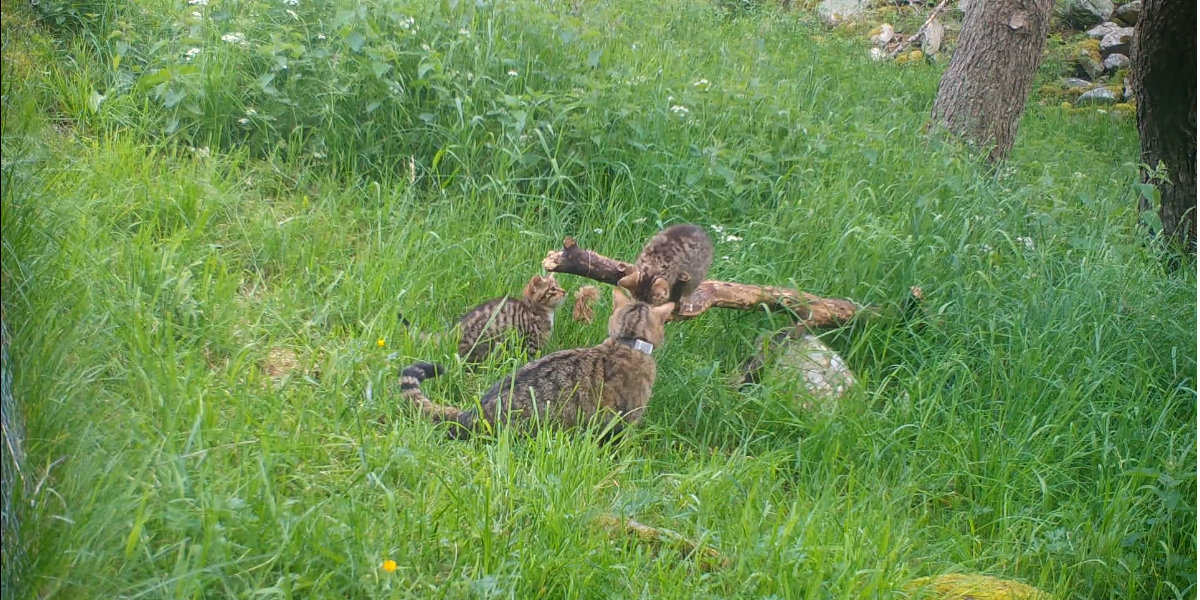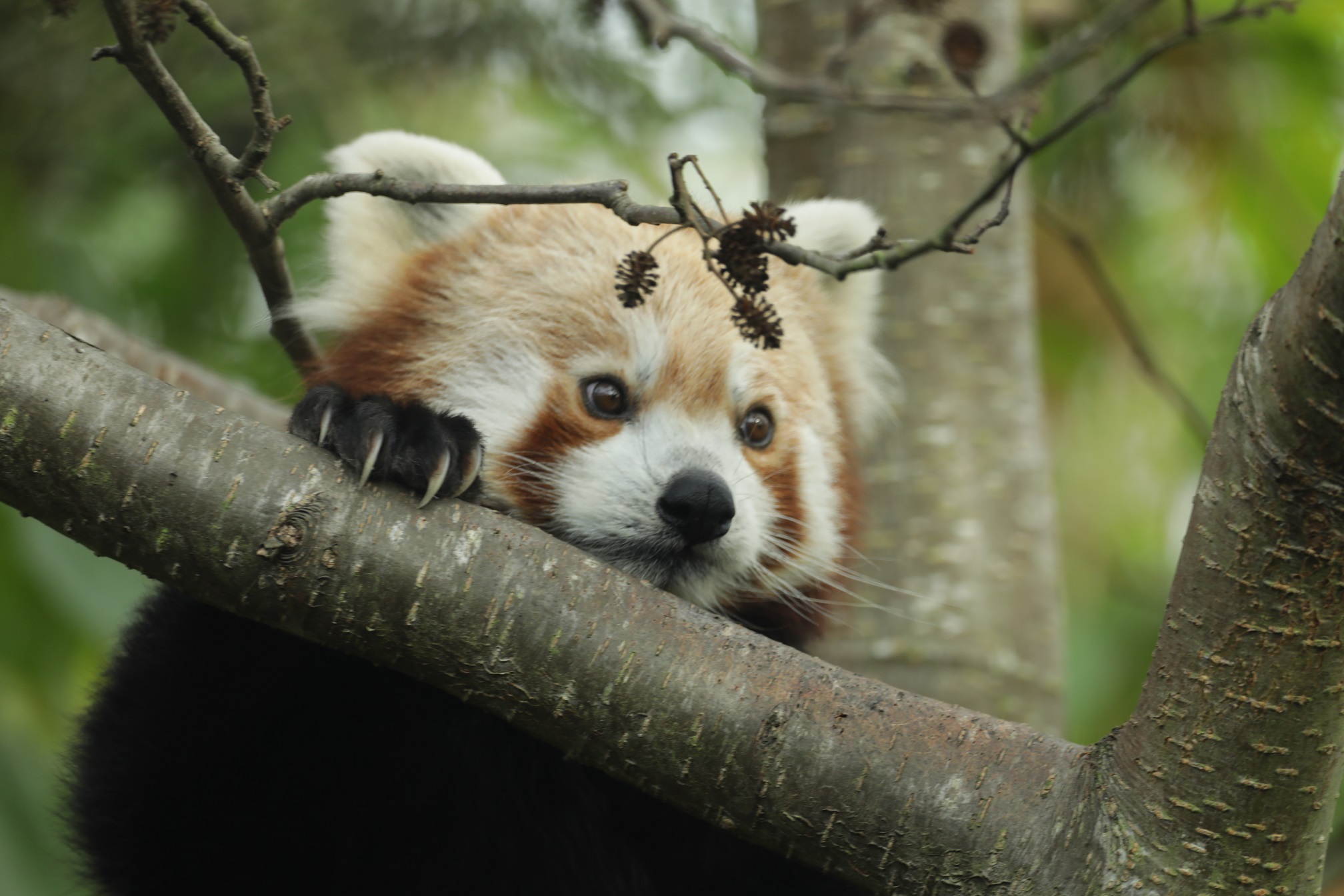Kitten births in the wild signal hope for Critically Endangered wildcats
Posted 24 Jun 2024

Wildlife conservationists have announced the birth of wildcat kittens in the Cairngorms National Park.
Following the release of 19 wildcats last summer by the Saving Wildcats partnership, led by the Royal Zoological Society of Scotland, at least two females have given birth in the wild. This marks a significant milestone in the project’s efforts to restore the wildcat to Scotland, after the species was determined to be on the verge of extinction in 2018.
Dr Keri Langridge, Saving Wildcats Field Manager, said, “We suspected that some of the females had given birth when their movement and activity changed very suddenly but didn’t know for sure until footage of the kittens was captured on our cameras.
“With the support of local landowners, gamekeepers and the local community, our field team has successfully managed to monitor and film these kittens in the wild – which is no simple task. We have taken extreme care not to disturb the mother and kittens, and we carry out all monitoring work under licence from NatureScot.
“We didn’t dare to dream that we would have wildcat kittens in the first year of releases, and seeing those kittens on the video was the most exciting moment of the project so far.”
Dr Helen Senn, lead for Saving Wildcats, said, “This is a major milestone for wildcat recovery in Scotland. These births demonstrate that the process of breeding wildcats for release into the wild is working, as those released animals have learned to hunt and survive – and now reproduce in their first breeding season, a clear indication that they are doing well.
“However, we have to bear in mind that life in the wild is hard and they will face may challenges. While the mortality rate for wildcat kittens in their first year of life can be high, we are hopeful for the future of these kittens.
“There is also the risk of interbreeding (hybridisation) between wildcats and domestic cats, despite our efforts to trap, neuter, vaccinate and release feral domestic cats in the local area. That’s why we always emphasise the important contribution to wildcat conservation that local people can make by ensuring their pet cats are neutered, as well as microchipped and vaccinated. While we know from their GPS-radio collars that the two females that have given birth have overlapped with male wildcats, we do not yet know their paternity.
“Once the wildcats are old enough, we will attempt to get a DNA profile from them. We are hopeful that they are indeed the offspring of male wildcats that were released last year – and the first of many more to come.”
Notes to Editors
[ENDS]
Images and video are available at – https://www.dropbox.com/scl/fo/n79jxbg8aww48tyu409kn/AC-lk06pec7rslBB3uAUAVE?rlkey=yb2xdlw5rgosjaokgy6ysr55e&dl=0
Images and video are free to use but must be credited to Saving Wildcats
Notes to editors
- Led by the Royal Zoological Society of Scotland, in collaboration with NatureScot, Forestry and Land Scotland (FLS), The Cairngorms National Park Authority, Norden’s Ark and Consejería de Sostenibilidad, Medio Ambiente y Economía Azul de la Junta de Andalucía, the Saving Wildcats partnership project is working to restore Scotland’s critically endangered wildcat population by breeding and releasing them into the wild and mitigating threats to the species.
- In June 2023, 19 wildcats were released into the Cairngorms Connect landscape within the Cairngorms National Park marking a historic milestone -the first release of wildcats in Britain.
- Now that releases are underway it is vital that the population is monitored and threats to the young population continue to be mitigated. Two primary threats to wildcats are interbreeding (hybridsation) with domestic cats and predator control activities.
- The project is funded with the contribution of the LIFE Programme of the European Union and the generous support of the Scottish Government, Garfield Weston Foundation, the National Trust for Scotland, the People’s Trust for Endangered Species, The European Nature Trust, players of People’s Postcode Lottery, and Rewilding Europe's European Wildlife Comeback Fund
- It is an offence to deliberately or recklessly capture, injure, kill or harass wildcats, disturb them in a den or to damage or destroy their breeding sites or resting places
- Of the 19 wildcats released in 2023, 16 are currently alive and are being monitored by the Saving Wildcats field team. A further two are presumed to be alive and have dispersed beyond the range the team can track them. One female cat died five weeks after release, a post-mortem examination carried out by our expert veterinary team revealed the cat sadly died of peritonitis, which is an infection in the abdominal cavity. Further information about the activities of the Saving Wildcats partnership over the last year can be found at https://savingwildcats.org.uk/oneyearon2024
- Wildcats bred for release are not available for public viewing. The public can view other wildcats which are on-show at Highland Wildlife Park and Edinburgh Zoo.
- People wishing to support the growing population can sponsor a wildcat https://savingwildcats.org.uk/sponsor
Partner notes
- The Royal Zoological Society of Scotland (RZSS) is a wildlife conservation charity which owns Edinburgh Zoo and Highland Wildlife Park. We safeguard threatened species from extinction: https://rzss.org.uk
- NatureScot is Scotland's nature agency. Responding to the twin crises of biodiversity loss and climate change, we work to protect and restore nature by inspiring everyone to value our natural world. Our goal is a nature-rich, net-zero future for Scotland. For more information, visit our website: https://nature.scot
- Forestry and Land Scotland (FLS) is the Government body responsible for the protection and expansion of Scotland's forests and woodlands: https://forestryandland.gov.scot/
- The Cairngorms National Park Authority was set up to ensure that the unique aspects of the Cairngorms – both the natural environment and the local communities – are cared for, sustained and enhanced for current and future generations to enjoy. The Cairngorms National Park Authority provides leadership to all those involved in the Cairngorms and works in partnership with a range of communities, businesses, non-government organisations and public sector partners to deliver practical solutions on the ground: https://cairngorms.co.uk/
- Norden’s Ark, based in Sweden, works to ensure endangered animals have a future: https://en.nordensark.se/
- Consejería de Sostenibilidad, Medio Ambiente y Economía Azul de la Junta de Andalucía, based in Spain, leads Europe’s most successful carnivore reintroduction of Iberian lynx: https://juntadeandalucia.es/medioambiente/site/portalweb/
- Cairngorms Connect is a partnership of neighbouring land managers (Wildland Limited, Forestry and Land Scotland, RSPB Scotland and NatureScot) working towards a 200-year vision to enhance habitat, species and ecological process across a vast 600 square kilometre area within the Cairngorms National Park. It is the largest habitat restoration project in the UK and is funded by the Endangered Landscapes Programme: https://cairngormsconnect.org.uk/
About Saving Wildcats (#SWAforLIFE)
- Saving Wildcats (#SWAforLife) is a European partnership project dedicated to Scottish wildcat conservation and recovery. We aim to prevent the extinction of wildcats in Scotland by breeding and releasing them into the wild.
For more information visit https://savingwildcats.org.uk
For further information, please contact comms@rzss.org.uk

